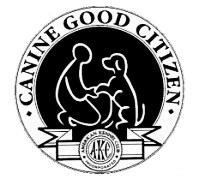The CANINE GOOD CITIZEN Test is an AKC certification program involving everyday
situations in a relaxed atmosphere. It seeks to identify and officially recognize
those dogs that possess the attributes that enable them to serve effectively as
personal companions and members in good standing within the community. The test
is to demonstrate that your dog knows basic commands in order to function acceptably
at home, in public places, and in the presence of other dogs.
The C.G.C. test is not a competitive obedience program and does not require precision
work in the execution of exercises.
To qualify for C.G.C. a dog must pass each of the ten (l0) test categories:
DEMONSTRATING CONFIDENCE AND CONTROL
|
|
- ACCEPTING A FRIENDLY STRANGER
- SITTING POLITELY FOR PETTING
- APPEARANCE AND GROOMING
- OUT FOR A WALK
(Walking on a Loose Leash)
- WALKING THROUGH A CROWD
|
- SIT AND DOWN ON COMMAND
Stay in Place (sit or down)
- COMING WHEN CALLED
- REACTING TO OTHER DOGS
- REACTIONS TO DISTRACTIONS
- SUPERVISED SEPARATION
|
TEST 1: ACCEPTING A FRIENDLY STRANGER

This test demonstrates that the dog will allow a friendly stranger to approach it and speak to the handler in a natural, everyday situation. The evaluator and handler shake hands and exchange pleasantries. The dog must show no sign of resentment or shyness, and must not break position or try to go to the evaluator.
TEST 2: SITTING POLITELY FOR PETTING

This test demonstrates that the dog will allow a friendly stranger to touch it while it is out with its handler. The dog should sit at the handler’s side as the evaluator approaches and begins to pet the dog on the head and body only. The dog may stand in place to accept petting. The dog must not show shyness or resentment.
TEST 3: APPEARANCE AND GROOMING

This practical test demonstrates that the dog will welcome being groomed and examined and will permit a stranger, such as a veterinarian, groomer or friend of the owner, to do so. It also demonstrates the owner’s care, concern and sense of responsibility. The evaluator inspects the dog, then combs or brushes the dog, and lightly examines the ears and each front foot.
TEST 4: OUT FOR A WALK (Walking on a Loose Leash)

This test demonstrates that the handler is in control of the dog. The dog may be on either side of the handler, whichever the handler prefers. There must be a left turn, a right turn and an about turn, with at least one stop in between and another at the end. The dog need not be perfectly aligned with the handler and need not sit when the handler stops.
TEST 5: WALKING THROUGH A CROWD

This test demonstrates that the dog can move about politely in pedestrian traffic and is under control in public places. The dog and handler walk around and pass close to several people (at least three). The dog may show some interest in the strangers, without appearing overexuberant, shy or resentful. The handler may talk to the dog and encourage or praise the dog throughout the test. The dog should not be straining at the leash.
TEST 6: SIT AND DOWN ON COMMAND/STAYING IN PLACE

This test demonstrates that the dog has training, will respond to the handler’s command to sit and down, and will remain in the place commanded by the handler (sit or down position, whichever the handler prefers). The handler may take a reasonable amount of time and use more than one command to make the dog sit and then down. When instructed by the evaluator, the handler tells the dog to stay and walks forward the length of a 20-foot line. The dog must remain in place, but may change positions.
TEST 7: COMING WHEN CALLED

This test demonstrates that the dog will come when called by the handler. The handler will walk 10 feet from the dog, turn to face the dog and call the dog. The handler may use encouragement to get the dog to come. Handlers may choose to tell dogs to “stay” or “wait,” or they may simply walk away, giving no instructions to the dog as the evaluator provides mild distractions (e.g., petting) .
TEST 8: REACTION TO ANOTHER DOG

This test demonstrates that the dog can behave politely around other dogs. Two handlers and their dogs approach each other from a distance of about 10 yards, stop shake hands and exchange pleasantries, and continue on for about 5 yards. The dogs should show no more than a casual interest in each other.
TEST 9: REACTIONS TO DISTRACTIONS

This test demonstrates that the dog is confident at all times when faced with common distracting situations, such as the dropping of a large book or jogger running in front of the dog. The dog may express a natural interest and curiosity and/or appear slightly startled, but should not panic, try to run away, show aggressiveness or bark.
TEST 10: SUPERVISED SEPARATION

This test demonstrates that a dog can be left with a trusted person, if necessary, and will maintain its training and good manners. Evaluators are encouraged to say something like, “Would you like me to watch your dog?” and then take hold of the dog’s leash. The owner will go out of sight for 3 minutes. The dog does not have to stay in position but should not continually bark, whine or pace unnecessarily or show anything stronger than mild agitation or nervousness.

You are allowed to talk to your dog and to encourage him during the exercises. FOOD
IS NOT ALLOWED DURING THE TEST. All tests are performed on-leash (leather or fabric).
Dogs should wear a well-fitting buckle or slip collar made of leather, fabric, or chain.
Special training collars, such as pinch or head collars are not acceptable.
BRING: A valid rabies certificate and your county registration, collar and leash, and a brush or comb for grooming.

